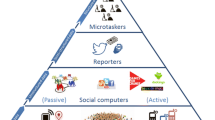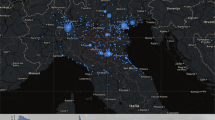Abstract
Over the last ten years, there has been a significant increase in crowd-sourcing applications for disaster management. Their success depends heavily on the behaviour of social media users, acting as human sensors during disaster monitoring and emergency response. Unlike their technological counterparts, human sensors are complex social entities, contributing in different ways to their collective task and creating varying participation patterns through social media. Failing to understand these participation patterns limits our capacity to evaluate the reliability of human sensing in different contexts. Based on an analysis of flood-related information contributed by Twitter users in Jakarta during the 2014/2015 and 2015/2016 monsoonal seasons, this study establishes four categories of human sensors and their respective levels of reliability for disaster management. The results have significant implications for how we frame expectations and develop reliance on the use of social media for disaster management. Importantly, the results will serve as a useful guide for understanding levels of incentive that may be required to motivate members of the different categories of social media users during emergencies and disasters.



Similar content being viewed by others
References
Acar, A., & Muraki, Y. (2011). Twitter for crisis communication: lessons learned from Japan's tsunami disaster. International Journal of Web Based Communities, 7(3), 392–402.
Alexander, D. E. (2014). Social media in disaster risk reduction and crisis management. Science and Engineering Ethics, 20(3), 717–733.
Atzmanstorfer, K., Resl, R., Eitzinger, A., & Izurieta, X. (2014). The GeoCitizen-approach: community-based spatial planning–an Ecuadorian case study. Cartography and Geographic Information Science, 41(3), 248–259.
Bird, D., Ling, M., & Haynes, K. (2012). Flooding Facebook-the use of social media during the Queensland and Victorian floods. Australian Journal of Emergency Management, The, 27(1), 27.
Brouwer, T. (2016). Potential of twitter derived flood maps: Comparing interpolation methods and assessing uncertainties (Master's thesis, University of Twente).
Brown-Paul, C., & Ross, S. (2014). Jakarta... towards food security. Practical Hydroponics and Greenhouses, 140, 20–26.
Bunce, S., Partridge, H., & Davis, K. (2012). Exploring information experience using social media during the 2011 Queensland floods: a pilot study. The Australian Library Journal, 61(1), 34–45.
Bunker, D., Levine, L., & Woody, C. (2015). Repertoires of collaboration for common operating pictures of disasters and extreme events. Information Systems Frontiers, 17(1), 51–65.
Earle, P. S., Bowden, D. C., & Guy, M. (2012). Twitter earthquake detection: earthquake monitoring in a social world. Annals of Geophysics, 54(6), 708–715.
Ehnis, C., & Bunker, D. (2012). Social media in disaster response: Queensland police service-public engagement during the 2011 floods. In ACIS 2012: Location, location, location: Proceedings of the 23rd Australasian Conference on Information Systems 2012 (pp. 1–10). ACIS.
Eilander, D., Trambauer, P., Wagemaker, J., & van Loenen, A. (2016). Harvesting social media for generation of near real-time flood maps. Procedia Engineering, 154, 176–183. doi:10.1016/j.proeng.2016.07.441.
Grasso, V., & Crisci, A. (2016). Codified hashtags for weather warning on Twitter: an Italian case study. PLoS Currents. Edition 1. doi:10.1371/currents.dis.967e71514ecb92402eca3bdc9b789529.
Gray, J. (2008). Quantum GIS: the open-source geographic information system. Linux Journal, 2008(172), 8.
Guo, B., Wang, Z., Yu, Z., Wang, Y., Yen, N. Y., Huang, R., & Zhou, X. (2015). Mobile crowd sensing and computing: the review of an emerging human-powered sensing paradigm. ACM Computing Surveys (CSUR), 48(1), 1–33.
Hartono, D. M., Novita, E., Gusniani, I., & Oriza, I. I. D. (2010). The role of water supply and sanitation during floods: case study of flood disaster in five regions of jakarta. International Journal of Technology, 1(1), 29–37.
Herfort, B., de Albuquerque, J. P., Schelhorn, S. J., & Zipf, A. (2014). Exploring the geographical relations between social media and flood phenomena to improve situational awareness a study about the River Elbe Flood in June 2013. In J. Huerta, S. Schade, C. Granell (eds.), Connecting a Digital Europe Through Location and Place (pp. 55–71). Heidelberg: Springer International Publishing.
Holderness, T., & Turpin, E. (2015). From social media to GeoSocial intelligence: Crowdsourcing civic co-management for flood response in Jakarta Indonesia. In S. Nepal et al. (Eds.), Social Media for Government Services (Vol. 2E, pp. 115–133). Switzerland: Springer International Publishing.
Houston, J. B., Hawthorne, J., Perreault, M. F., Park, E. H., Goldstein Hode, M., Halliwell, M. R., et al. (2015). Social media and disasters: a functional framework for social media use in disaster planning, response, and research. Disasters, 39(1), 1–22.
Hughes, A. L., St Denis, L. A., Palen, L., & Anderson, K. M. (2014). Online public communications by police & fire services during the 2012 hurricane Sandy. In Proceedings of the 32nd annual ACM conference on Human factors in computing systems (pp. 1505–1514). ACM.
Java, A., Song, X., Finin, T., & Tseng, B. (2007). Why we twitter: understanding microblogging usage and communities. In Proceedings of the 9th WebKDD and 1st SNA-KDD 2007 workshop on Web mining and social network analysis (pp. 56–65). ACM.
Jones, N., Clark, J., & Tripidaki, G. (2012). Social risk assessment and social capital: a significant parameter for the formation of climate change policies. The Social Science Journal, 49(1), 33–41.
Kaigo, M. (2012). Social media usage during disasters and social capital: twitter and the great East Japan earthquake. Keio Communication Review, 34(1), 19–35.
Kohler, T., Steghöfer, J. P., Busquets, D., & Pitt, J. (2014). The value of fairness: Trade-offs in repeated dynamic resource allocation. In Self-Adaptive and Self-Organizing Systems (SASO), 2014 I.E. Eighth International Conference on (pp. 1–10). IEEE.
Kurka, D. B., & Pitt, J. (2016). Distributed distributive justice. In Self-Adaptive and Self-Organizing Systems (SASO), 2016 I.E. 10th International Conference on (pp. 80–89). IEEE.
Mäkinen, M., & Kuira, M. W. (2008). Social media and postelection crisis in Kenya. The International Journal of Press/Politics, 13(3), 328–335.
McLennan, B., & Handmer, J. (2014). Sharing responsibility in Australian disaster management. East Melbourne. http://www.bushfirecrc.com/sites/default/files/sharingresponsibilityfinal_report.pdf: Bushfire CRC Accessed 11 Nov 2016.
Middleton, S. E., Middleton, L., & Modafferi, S. (2014). Real-time crisis mapping of natural disasters using social media. IEEE Intelligent Systems, 29(2), 9–17.
Muralidharan, S., Rasmussen, L., Patterson, D., & Shin, J. H. (2011). Hope for Haiti: an analysis of Facebook and twitter usage during the earthquake relief efforts. Public Relations Review, 37(2), 175–177.
Obe, R. O., & Hsu, L. S. (2015). PostGIS in action. Greenwich: Manning Publications Co.
Ogie, R. I. (2016). Adopting incentive mechanisms for large-scale participation in mobile crowdsensing: from literature review to a conceptual framework. Human-centric Computing and Information Sciences, 6(24). doi:10.1186/s13673-016-0080-3.
Ogie, R., Holderness, T., Dunbar, M., & Turpin, E. (2017a). Spatio-topological network analysis of hydrological infrastructure as a decision support tool for flood mitigation in coastal mega-cities. Environment and Planning B: Urban Analytics and City Science, 44(4), 718–739.
Ogie, R. I., Dunn, S., Holderness, T., & Turpin, E. (2017b). Assessing the vulnerability of pumping stations to trash blockage in coastal mega-cities of developing nations. Sustainable Cities and Society, 28, 53–66. doi:10.1016/j.scs.2016.08.022.
Ostrom, E. (1990). Governing the commons: the evolution of institutions for collective action. Cambridge, England: Cambridge University press.
Paul, S. K., & Routray, J. K. (2010). Flood proneness and coping strategies: the experiences of two villages in Bangladesh. Disasters, 34(2), 489–508.
Peary, B. D., Shaw, R., & Takeuchi, Y. (2012). Utilization of social media in the east Japan earthquake and tsunami and its effectiveness. Journal of Natural Disaster Science, 34(1), 3–18.
Perez, P., du Chemin, T. H., Turpin, E., & Clarke, R. (2015). Citizen-driven flood mapping in Jakarta: a self-Organising socio-technical system. In Self-Adaptive and Self-Organizing Systems Workshops (SASOW), 2015 I.E. International Conference on (pp. 174–178). IEEE.
Pitt, J., Busquets, D., & Riveret, R. (2013). Formal models of social processes: the pursuit of computational justice in self-organising multi-agent systems. In Self-Adaptive and Self-Organizing Systems (SASO), 2013 I.E. 7th International Conference on (pp. 269–270). IEEE.
Pitt, J., Busquets, D., & Riveret, R. (2015). The pursuit of computational justice in open systems. AI & SOCIETY, 30(3), 359–378.
Poblet, M., García-Cuesta, E., & Casanovas, P. (2017). Crowdsourcing roles, methods and tools for data-intensive disaster management. Information Systems Frontiers, 1–17. doi:10.1007/s10796-017-9734-6.
Pohl, D., Bouchachia, A., & Hellwagner, H. (2012). Automatic sub-event detection in emergency management using social media. In Proceedings of the 21st International Conference on World Wide Web (pp. 683–686). ACM.
Power, R., Robinson, B., Colton, J., & Cameron, M. (2014). Emergency situation awareness: twitter case studies. In International Conference on Information Systems for Crisis Response and Management in Mediterranean Countries (pp. 218–231). Springer International Publishing.
Quinn, S. (2017). Using small cities to understand the crowd behind OpenStreetMap. GeoJournal, 82(3), 455–473.
Rogstadius, J., Vukovic, M., Teixeira, C. A., Kostakos, V., Karapanos, E., & Laredo, J. A. (2013). CrisisTracker: crowdsourced social media curation for disaster awareness. IBM Journal of Research and Development, 57(5), 4–1.
Rosenberger, M., Lehrer, C., & Jung, R. (2016). Integrating data from user activities of social networks into public administrations. Information Systems Frontiers, 19(2), 253–266.
Sakaki, T., Okazaki, M., & Matsuo, Y. (2013). Tweet analysis for real-time event detection and earthquake reporting system development. IEEE Transactions on Knowledge and Data Engineering, 25(4), 919–931.
Skarlicki, D. P., & Folger, R. (1997). Retaliation in the workplace: the roles of distributive, procedural, and interactional justice. Journal of Applied Psychology, 82(3), 434–443.
Starbird, K., Palen, L., Hughes, A. L., & Vieweg, S. (2010). Chatter on the red: what hazards threat reveals about the social life of microblogged information. In Proceedings of the 2010 ACM conference on Computer supported cooperative work (pp. 241–250). ACM.
Takahashi, B., Tandoc, E. C., & Carmichael, C. (2015). Communicating on twitter during a disaster: an analysis of tweets during typhoon Haiyan in the Philippines. Computers in Human Behavior, 50, 392–398.
The Jakarta Post (2015). Indonesian disaster report for first quarter of 2015. http://www.thejakartapost.com/adv/2015/09/30/indonesian-disaster-report-first-quarter-2015.html. Accessed 14 March 2017.
Tyler, T. R., & Blader, S. L. (2000). Cooperation in groups: procedural justice, social identity, and behavioral engagement. Philadelphia: Psychology Press.
Vieweg, S. E. (2012). Situational awareness in mass emergency: a behavioral and linguistic analysis of microblogged communications. Ph.D. thesis, University of Colorado at Boulder.
Weerakkody, V., Irani, Z., Kapoor, K., Sivarajah, U., & Dwivedi, Y. K. (2016). Open data and its usability: an empirical view from the Citizen’s perspective. Information Systems Frontiers, 19(2), 285–300.
Yin, J., Lampert, A., Cameron, M., Robinson, B., & Power, R. (2012). Using social media to enhance emergency situation awareness. IEEE Intelligent Systems, 27(6), 52–59.
Zhou, X., & Chen, L. (2014). Event detection over twitter social media streams. The VLDB Journal, 23(3), 381–400.
Acknowledgements
This work was funded under the auspices of the Australian National Data Service (ANDS) through the National Collaborative Research Infrastructure Strategy Program [ANDS MODC 15, 2014], the Department of Foreign Affairs and Trade, Australia (DFAT 2014) [Agreement Number 71984], Twitter Data Grant (2014) and the University of Wollongong Global Challenges Program Seed Funding (2014) and Challenges Grant (2015).
Author information
Authors and Affiliations
Corresponding author
Rights and permissions
About this article
Cite this article
Ogie, R.I., Forehead, H., Clarke, R.J. et al. Participation Patterns and Reliability of Human Sensing in Crowd-Sourced Disaster Management. Inf Syst Front 20, 713–728 (2018). https://doi.org/10.1007/s10796-017-9790-y
Published:
Issue Date:
DOI: https://doi.org/10.1007/s10796-017-9790-y




